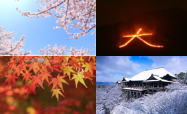Gravity(Attraction) of Kyoto19 Kyoto dialect, Calming the mind
Yoshie Doi

Being born and raised in Kyoto, I was not aware that I was speaking Kyoto dialect. I assumed I was speaking standard Japanese. However, when I give lectures in the Tokyo metropolitan area, people always say to me, “I’m happy to hear Kyoto dialect today.
The intonation is typical of Kyoto dialect, with vowels being stretched out, such as “I’ve been shitaharu” (I’ve been doing ○○), “roji” (alley), and “arigato” (thank you).
I often call long-established restaurants, and when I hang up the phone, they always say “Thank you very much.” Also, when they want to express how happy they are, they say “Thank you very much, I’m happy.” It makes me happy too. The proprietress of a long-established restaurant speaks gently and with a comfortable rhythm, and when I talk to her, I realize, “Ah, I’m in Kyoto.” Perhaps the tempo at which she speaks can be called Kyoto tempo.
Even in the world of language, there is a softer tone to the words spoken directly. Over the long history of the capital, even as those in power changed and friends and enemies changed, this defensive measure that allowed for flexible responses may have given rise to the ambiguity of Kyoto dialect.
There is a famous story about Natsume Soseki who, when he invited out a maiko in Gion, assumed the reply “Hey, thank you” meant OK, so when he called the maiko who didn’t show up at the appointed time, she only said “Hey, thank you.” “Ookini” is a word that includes a situational assessment and can be interpreted as either yes or no. In advanced conversations, the Kyoto dialect sometimes has the exact opposite meaning.
Am I the only one who thinks that Kyoto has developed a kind of sensory language, or a language that conveys feelings like “hokkori” (warmth) and “hannari” (elegance)? In Osaka dialect, there is a word called “bochibochi.” “Are you making a profit?” “Hey, bochibochi.” In Kyoto dialect, it becomes “Are you making a profit?” “Hey, thank you, bochibochi yawaa.
In Kyoto dialect, when we ask for something, we say “Thank you, Otano moushimasu,” and we are asking without waiting for the other person’s reply. I once had a bitter experience where the other person assumed it was OK, even though I hadn’t replied.
A typical phrase used to describe Kyoto is “Sanshisuimei:mountain vistas and clear waters.” Rai Sanyo of the Edo period coined the phrase while looking east from the Kamo River in his study in Marutamachi, where the mountains are dyed purple. The phrase refers to the time when the sunset forms. Although it is now used as an adjective, it originated when Rai Sanyo wrote a letter saying, “Please come when the mountains are beautiful.”
Many beautiful words remain in Kyoto. The word ” Sanshisuimei:mountain and river beauty” is now a synonym for describing Kyoto, and it describes the scenery that comes to mind. Perhaps it is the high level of culture of the Kyoto people, who cherish this kind of spirit, that has created the Kyoto that we all admire.
As the saying goes, “Ten generations in Kyoto, three generations in Tokyo, one generation in Osaka,” it seems that to be recognized as a Kyoto native, one needs to have lived there for several generations, but perhaps it’s because of my age that I want to preserve this laid-back Kyoto dialect.
The end of document
Translated by Masami Otani
